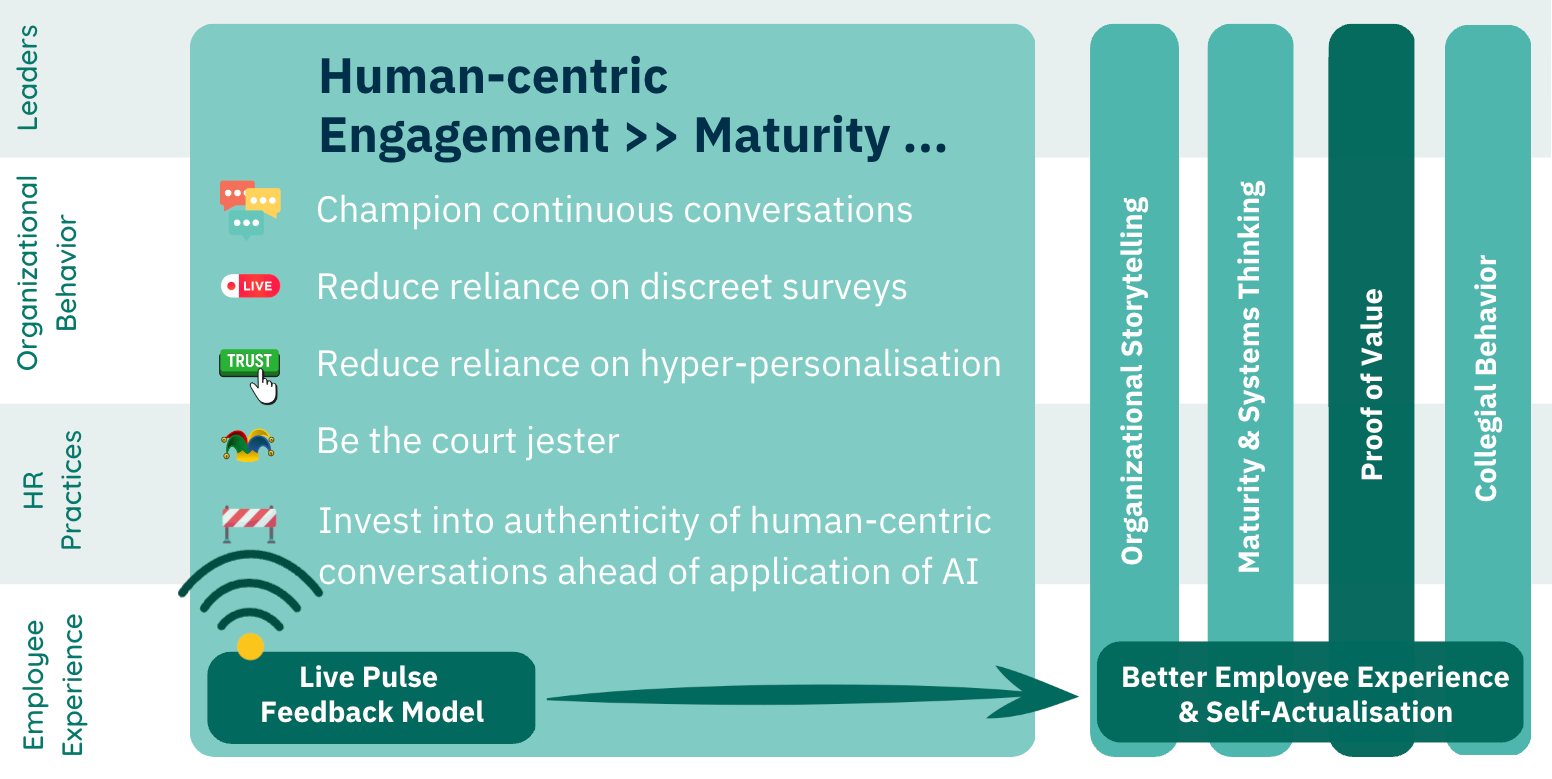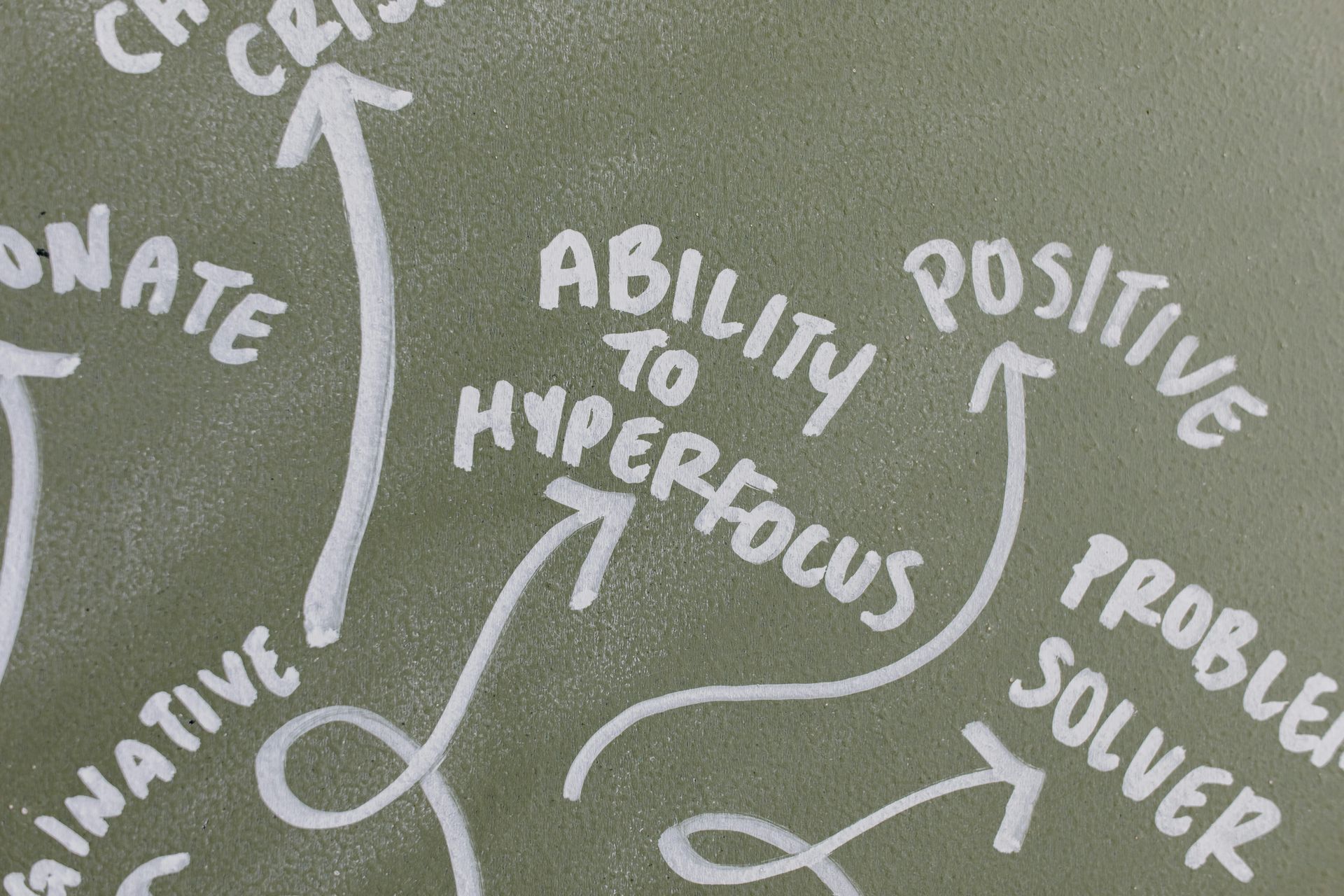Modern Workforce Connections and Performance Strategies
Employee engagement challenges are a reflection of the balancing act between employee buy-in and productivity. The success and failure of engagement are measured by talent retention or quiet quitting, if it were possible to measure it somehow. The elephant in the room affecting the relationship between employees and employers is that productivity growth rate is slowing (CEPR). At the same time, the trend of quiet quitting is persistent. In this context, artificial intelligence (AI) related excitement is often perceived as the door into a future where productivity is not constrained by human capacity and employers expect to find better ways of dealing with employee engagement overall.
Some people embrace the proposition of AI promised advancements with open arms, some fear it. In my opinion, there is an important subtlety that is easy to overlook. Irrespective of the opinions on where the future lies, we can fail without dealing with that subtlety. In the guise of a court jester, I would like to offer an opinion on the best way of embracing the revolution happening right now.
Before talking about the future, it is important to acknowledge where we are today. Evidence suggests that the overall state of employee engagement today is mediocre at best. AI related productivity growth does not excuse us from dealing with human-centric root causes that are responsible for the current state of affairs.
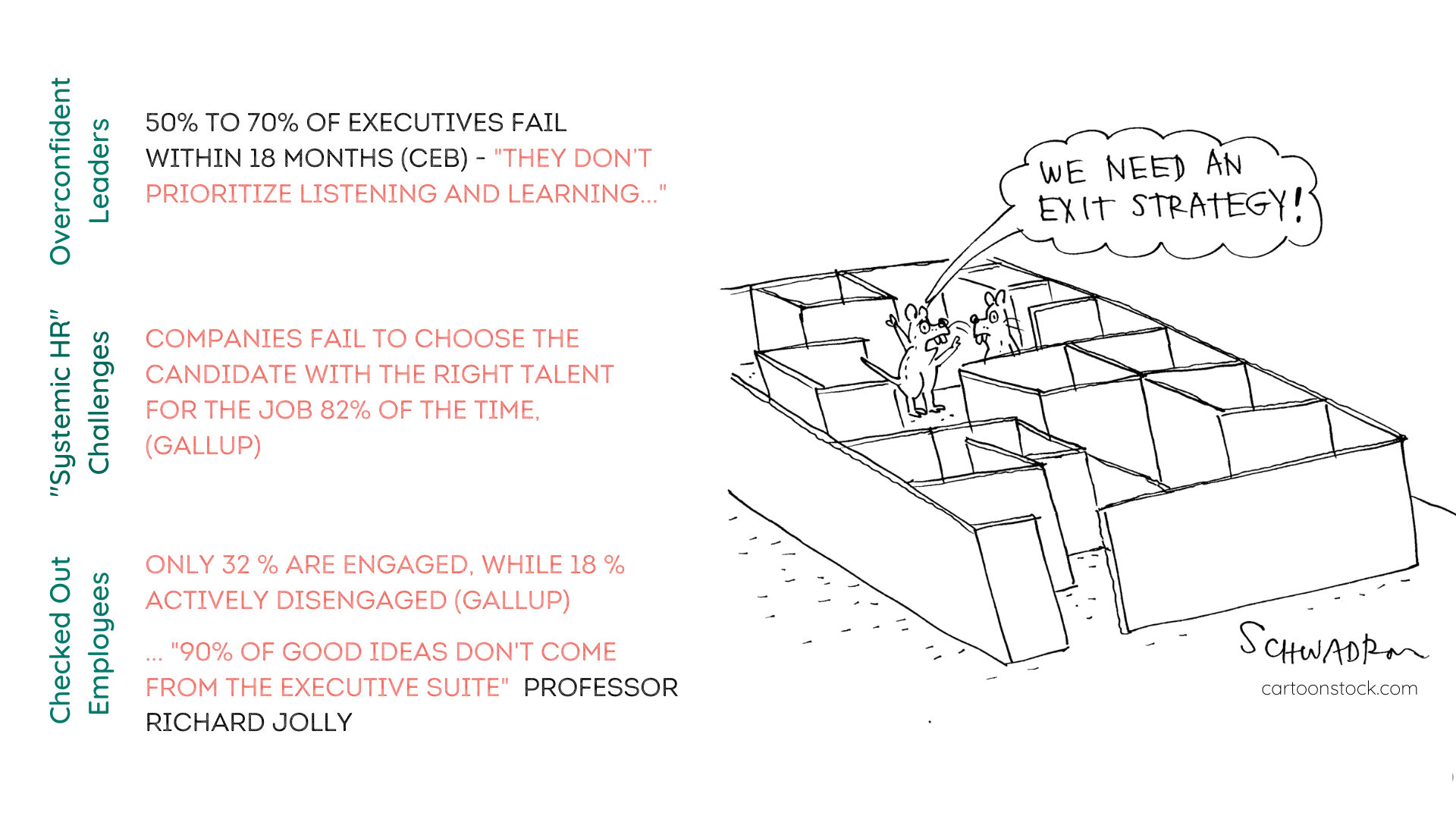
Organizational behavior has evolved from autocratic to a blend of autocratic, custodial, and supportive. If the desired state is about embracing a fully collegial organizational behavior model, then this goal is probably hard to achieve for most as of today.
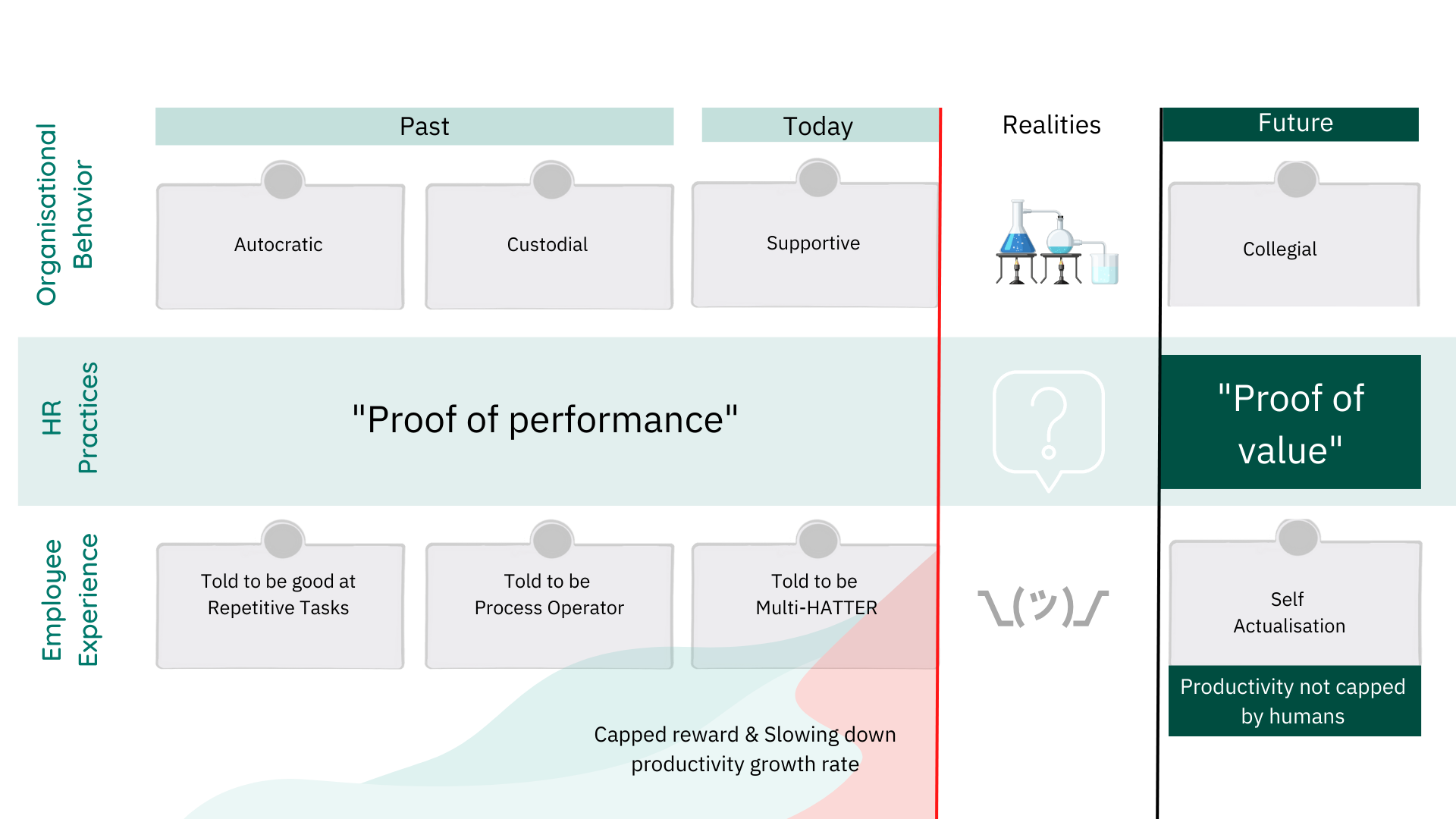
* Read more here on defintion of each organizational behavior model the relationship between Collegial model and Croup Intelligence.
In line with organizational behavior and advances in workplace technology, employees have been hand-held through the journey of "you need to be a good repetitive worker" to today's common career expectation of "you need to be capable of wearing multiple hats". High performing employees are resisting this trend and are saying they want something that allows self-actualisation. The introduction of AI technologies in the workplace merely adds to the pressure that employees are experiencing.
Throughout history, HR's main mission has been skewed towards operational concerns and a “proof of performance”. However, new business models, socio-economic changes, and talent retention pressures are forcing changes to the status quo. Organizations that can transition from “proof of performance” to "proof of value" will succeed where others fail.
Where we are today can be characterized by asking these three questions:
- Is the collegial organizational behavior model achievable?
- What does innovation in HR look like?
- What does employee engagement look like?
Both employees and organizations often find themselves trapped in the status quo and are just not ready for concepts such as radical transparency.
We all know that change is hard. The gotcha, though, is that solutions can be very simple; we just need to stop catastrophizing. In the case of improvements to employee engagement, the solution is lost somewhere in the forest of misdirected expectations of surveys, assessments, and AI driven “Culture Operating System”. In all of these patterns, real conversation takes precedence just below "measurement." The left hemisphere dominates the right hemisphere of the organizational brain, which is why we see poor employee experience today - organizations are not really capable of being mindful. It is possible to argue that
we live in a deluded world.
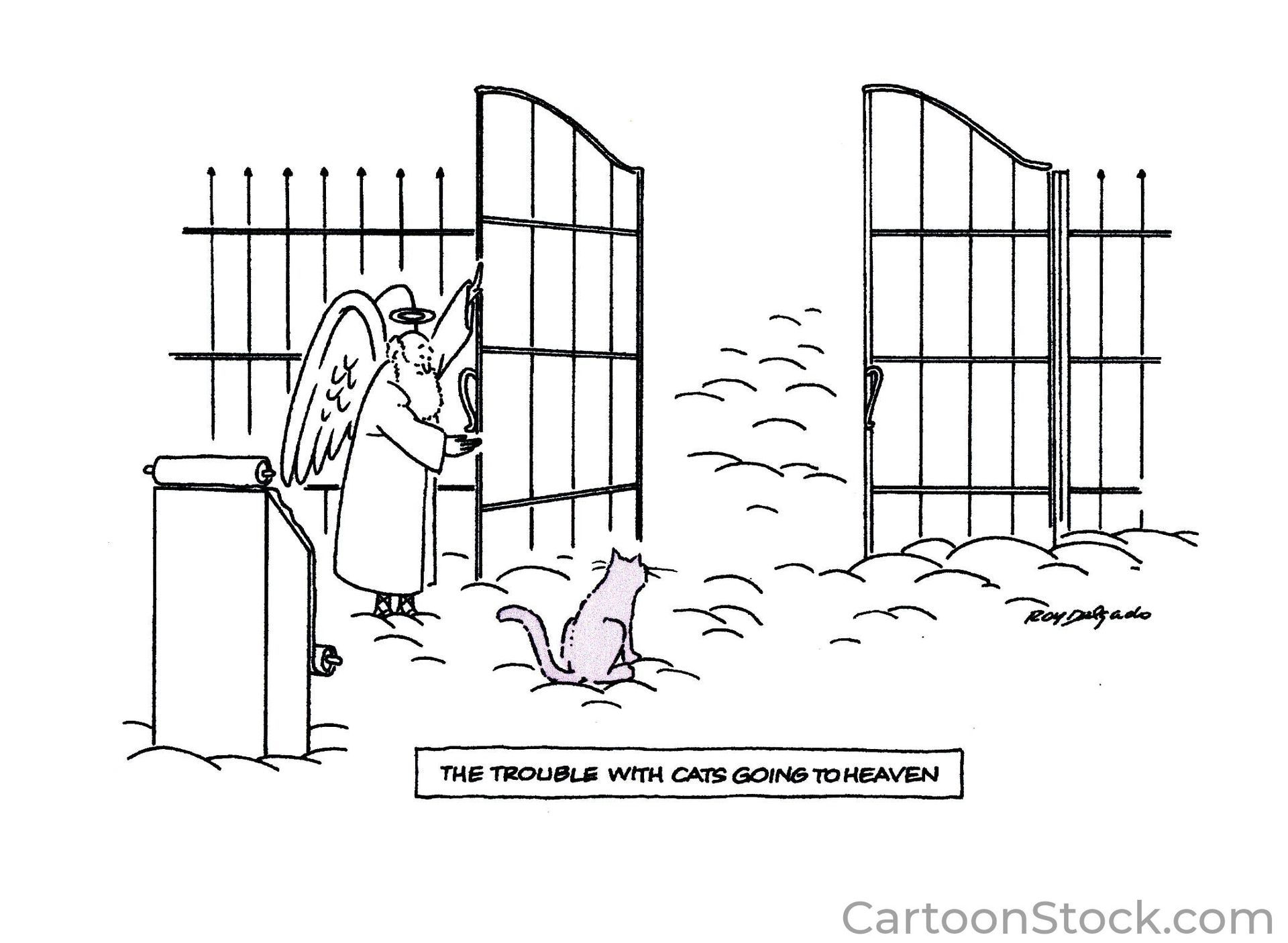
There are three key fears that translate into resistance for change:
- Executives' fear of unpredictability affecting business value. Organizations fear elevating high performing employees into positions influencing strategy, and thus miss out on transformative change.
- Second fear is rooted in the inability to let go of legacy management practices. This suffocates employee engagement at the root.
- The third fear is one of the basic human emotions - the fear of looking vulnerable. This fear fuels the grip of surveys, tightly controlled narratives, and legacy management practices.

It is said that "fears you don't face, become your limitation". Resistance and fears, that I mentioned earlier, translate to the symptoms of poor state of leadership and employee engagement. Organizations that are not brave enough to reconsider their approach to learning how employees really feel will limit their business value potential.
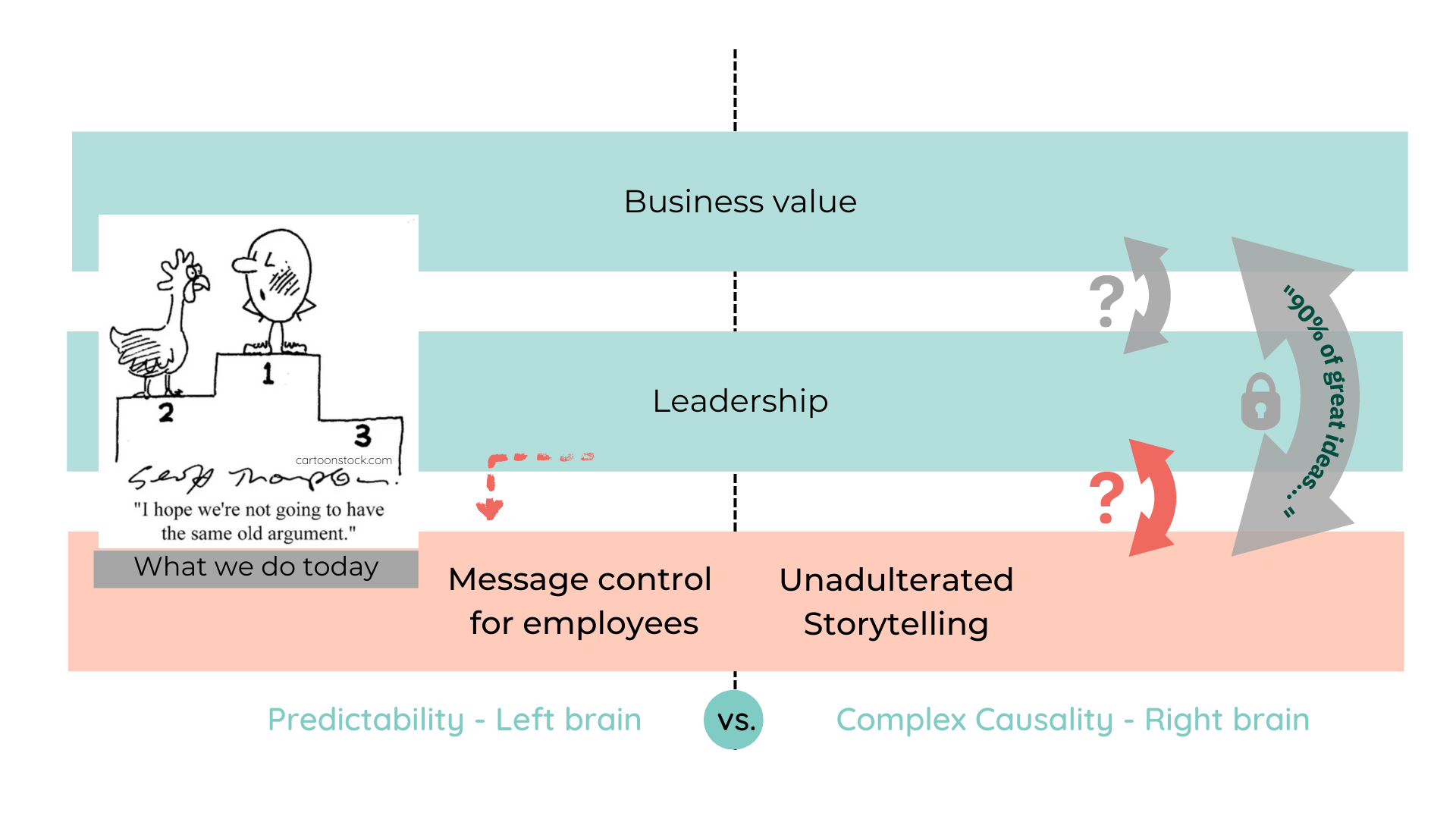
In the absence of transparent and organization-wide reflective thinking, asking employees how they feel is a cynical exercise. Quiet quitting is rooted in this experience.
Symptoms of poor employee engagement can collectively be ascribed to a "Survey Trap" mindset. Your most important employees are turned off by surveys. Yet, most organizations feel that they must run surveys. Hence, we create a vortex of poor employee engagement via a survey trap.
It is typical for leaders to reflect on poor employee engagement through the lens of “I wish we could communicate better and more frequently”. However, what is the point of trying to hammer in a message, or a mantra, that employees fundamentally do not trust? Leaders often misunderstand the subtlety of employees' mistrust relating not to the message itself but the strategy of achieving the stated mission. At the same time, standard operating models do not allow employees to meaningfully influence strategic planning typically accomplished at leadership offsites.
Surveys are the default approach for attempting to give employees some voice and influence. However, given that only 33% of employees report being engaged (Gallup) and only 22% of surveyed companies obtain meaningful results from their employee engagement surveys (Enodo Global, 2022), it is fair to deduce that surveys cannot be the mainstay of engagement.
The more complex your challenges are, the less insightful or useful your survey results will be. It is important to be humble in understanding the personas of high, medium, and low level performers in the organization. High-performers expect continuous and adult conversations, as opposed to lagging information extraction exercises (aka surveys).
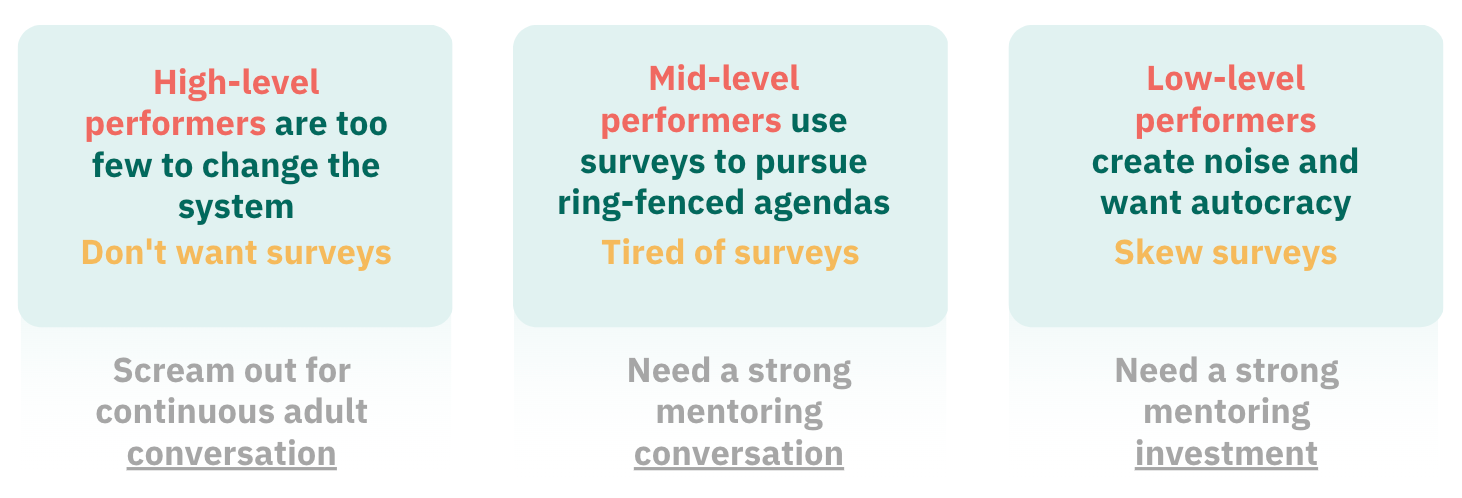
Organizations need to find a way of receiving context-aware data points without needing to run discreet surveys. Organizations, just like humans, can suffer from dementia. Lagging and cynical communication structures will result in poor outcomes (Conway’s Law).
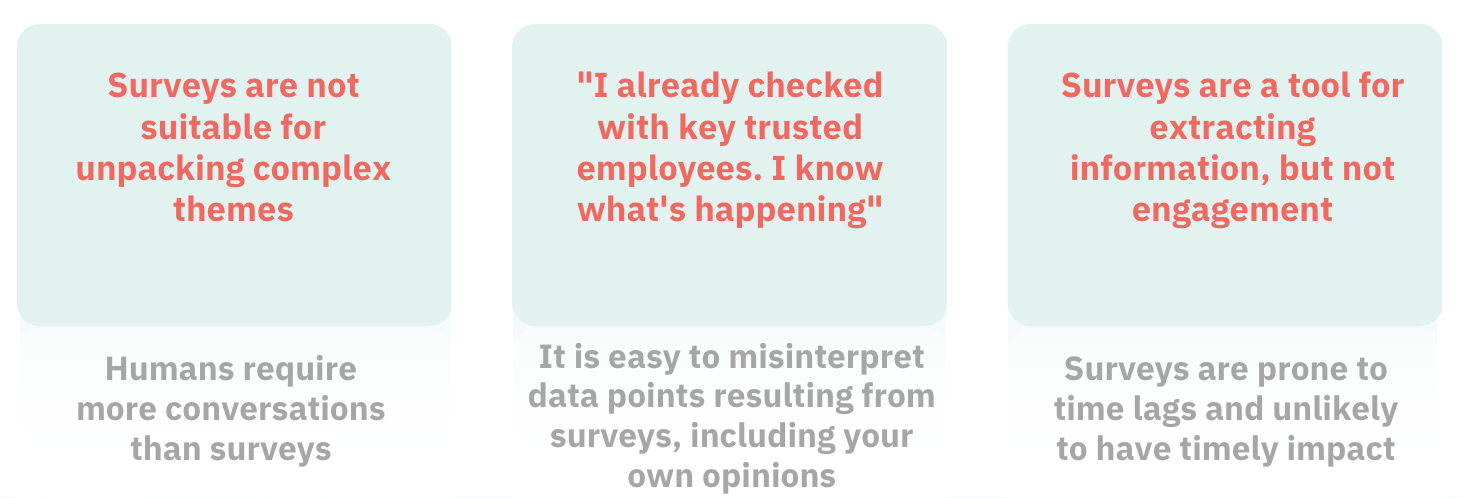
Left brain influenced love with algorithmic message dissemination is the reason why "humanity lost the first encounter with the 'curating' AI" (Tristan Harris and Aza Raskin, The A.I. Dilemma). We need to become mindful, which means we need to embrace complex sense-making models (Integrating Chaos: Building Resilient Organizations with Chaos Theory by Paul Millerd). Only this way we, as humanity, can be relevant in the future.
Organizations need to stop expecting predictability to arise from message and mantra management. The adherence to perceived safety of legacy patterns, such as lagging discreet surveys, is limiting the ability to remain competitive. What is the value in doubling down on patterns that got us into trouble in the first place? In today’s complex world, the saying that “change is the only constant in life” is more pronounced than ever.
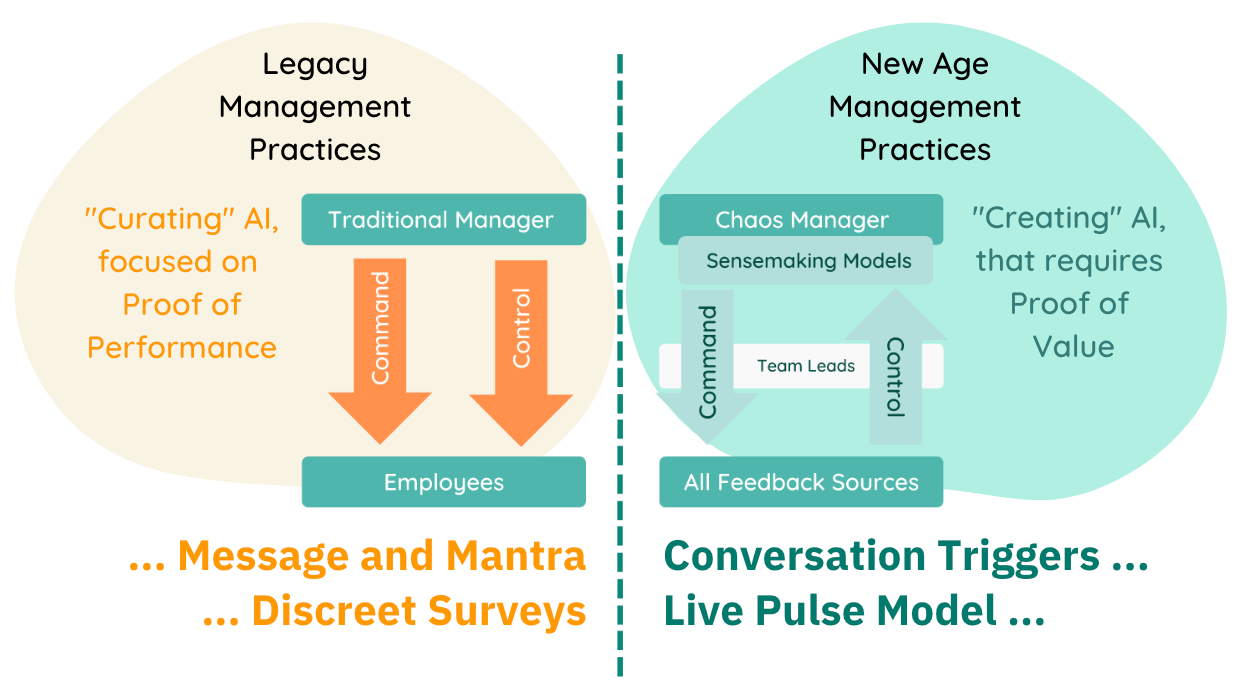
The future of employee engagement belongs to a universe of authentic, human-centric data points wrapped in the systemic honesty mechanisms that result in unavoidable conversation triggers. AI, if supplied with authentic data, can be a useful tool because it does not suffer from the loss of face. However the universe needs to be human-centric and psychologically safe.
There is a serious danger of doubling down on AI without addressing the need for real and continuous conversations. If you end up surrounded by silence and subversive compliance, then you have probably replaced the survey trap with some other trap.
There is a way of escaping the survey trap right now.
The solution is to replace discreet surveys with a Live Pulse model, whilst taking your teams through the journey of transparency. Most people say that "my organization is not ready for transparency". I always respectfully disagree because:
a) it is a lazy way of avoiding the need to face the music
b) actually, people already do half of the transparency job via the broadcasting of "kudos"
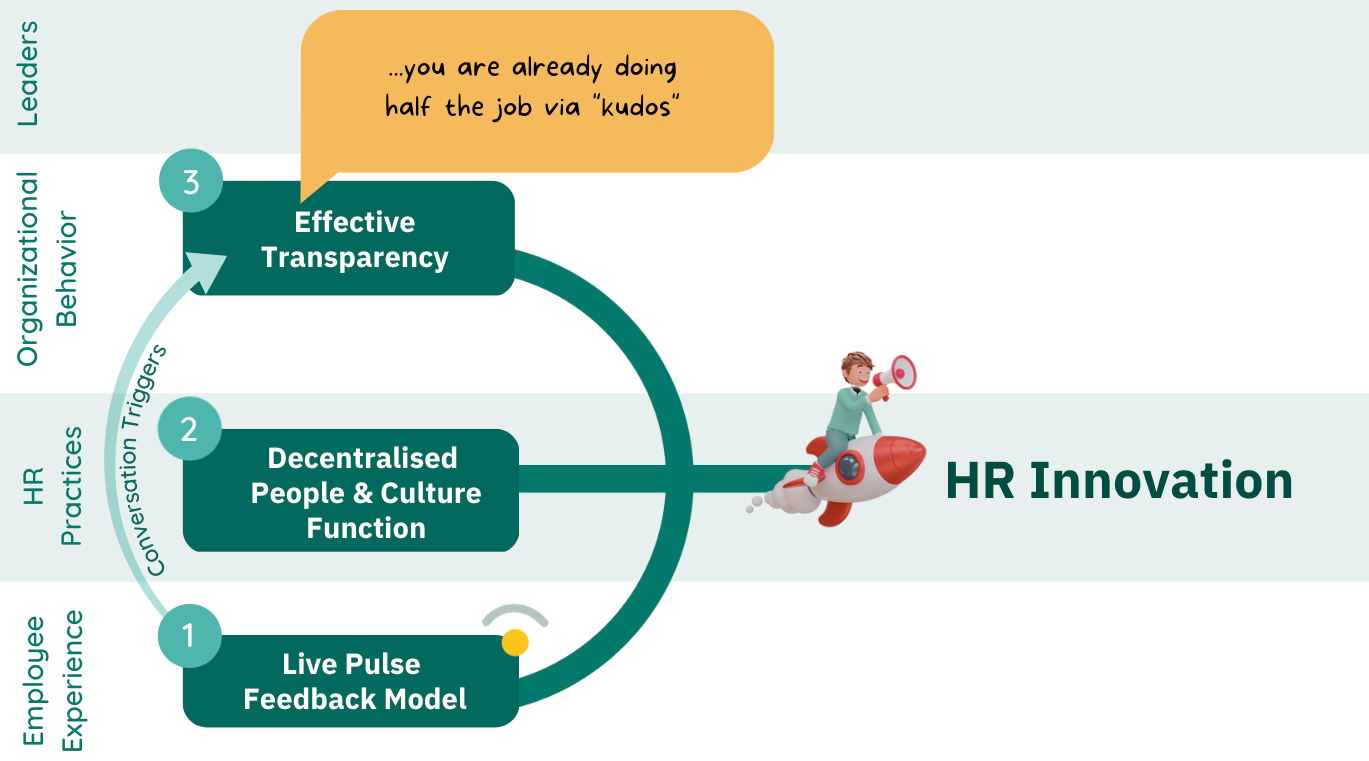
Live pulse feedback is a nurturing force that will eventually give rise to horizontal leadership.
Again, people typically fear the redistribution of power. However, a decentralized system is not about tinkering with how your matrix organization looks through the lens of an org chart. It is a mindset and culture that allows ideas and evidence to penetrate any barrier. This capability is key for authentic mutual accountability and alignment of all teams to a common goal.
By replacing the command-and-control system with a decentralized system driven by horizontal leadership, the organization will achieve "proof of value" and collegial organizational behavior.
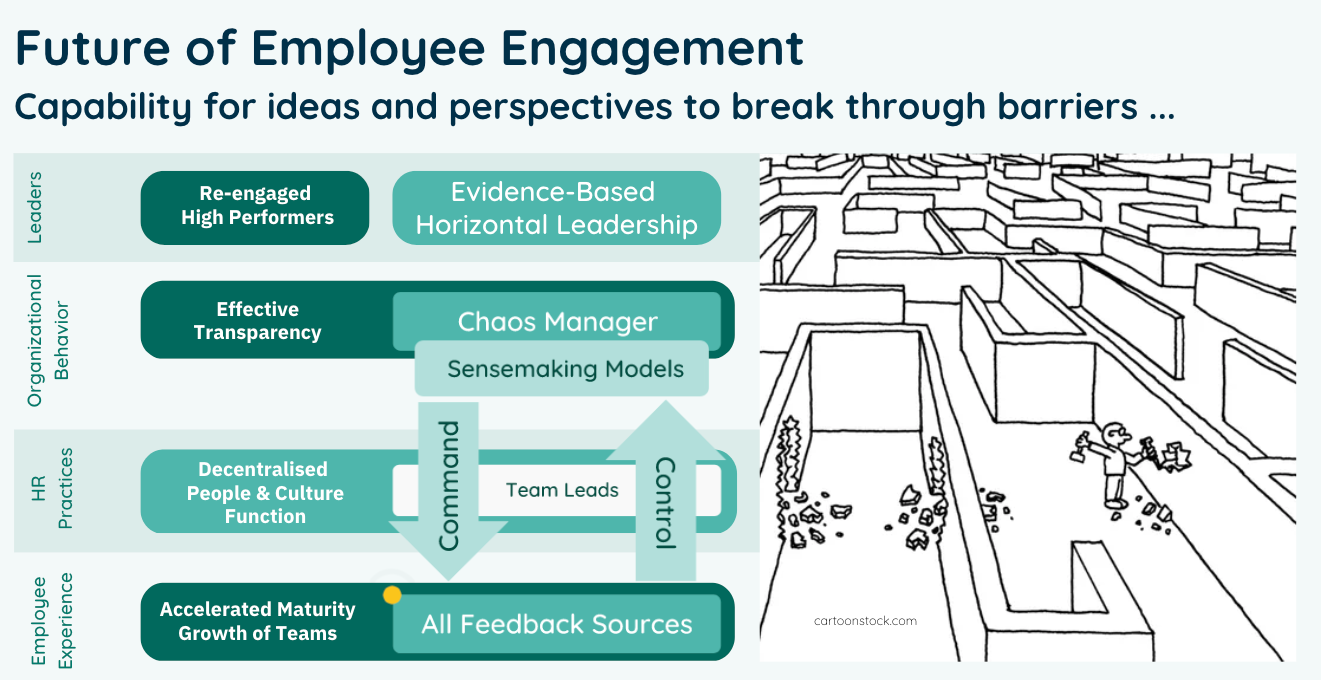
Conclusion
The future of employee engagement, irrespective of the role of AI, depends on authenticity of data points that represent employee experiences. Winning organizations will be the ones that invest into a highly human centric Live Pulse model for information flow. Organizations that are failing their employees today will not find any magical alternatives through AI, hyper personalisation, or other approaches.
Post Scriptum
Enabling a Live Pulse employee engagement model can be a 5 minute job with the help of Neelix.IO.
Live Pulse does not entail throwing away operational HR processes. It is natural that organizations need to adhere to regulations and have structured approaches to management of employee journeys. Live Pulse is a complementary pattern that reduces reliance on discrete surveys and boosts authenticity of experiential data points, and does so without the need to install “surveillance” systems.
If you aim to establish a psychologically safe culture, steer away from solutions that trawl emails, MS teams posts, calendars in order to algorithmically calculate the Team Morale measure. A better pattern is to leverage the “push” method adopted by Neelix because it builds a data lake of human-centric and humor-assisted reflections of what people truly feel. Interactive infographics from Neelix empower leaders with an easy 30,000 ft view of employee morale, and provide insights into persistent trends, correlations and inter-dependencies between themes.
Overall journey typically consists of two phases:
Phase 1 - The awakening of measurable data points:
- Reduce HR overheads by running fewer surveys and assessments; instead, implement a Live Pulse model for employee feedback that goes beyond kudos. Do this right now. This approach is highly human-centric and, in the first phase, specifically targets high and medium performers.
- Complement live pulse feedback with humorous "roasting" sessions. Humor and psychological safety are critical; as the saying goes - "if you plan to be honest with someone, make sure they laugh”.
In about a year you will establish rails for effective and alive transparency, and potentially arrest talent retention challenges.
Phase 2 - Storytelling and transformative inspect-and-adapt patterns:
- Measurable feedback, discussed openly, will start creating a de-facto decentralized system. For example, horizontal leadership will begin emerging organically without the need to revisit organizational structures
- Allow employees to build and maintain a value tree depiction of how an individual team's objectives and perspectives map to the commonly agreed top organizational goal.
